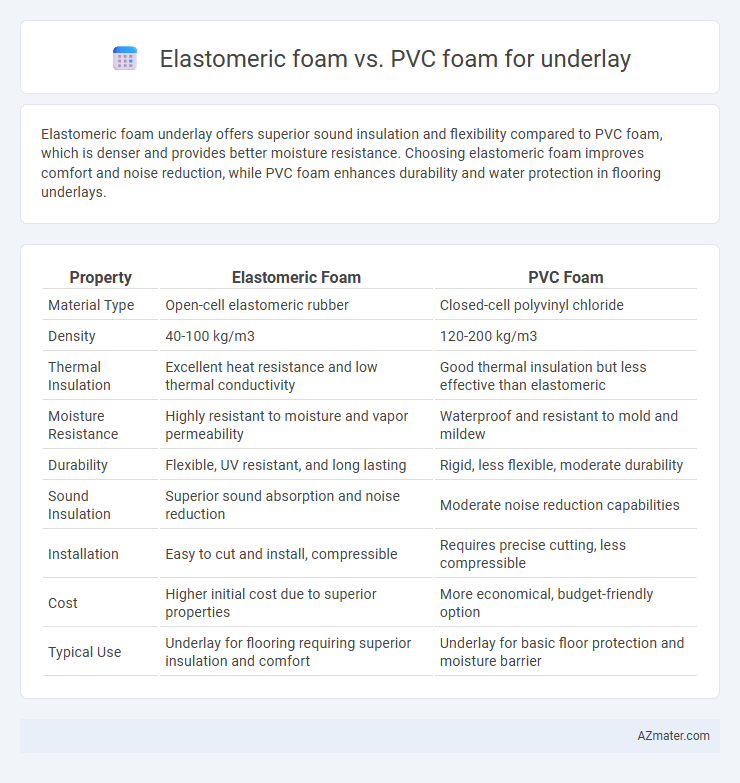Elastomeric foam underlay offers superior sound insulation and flexibility compared to PVC foam, which is denser and provides better moisture resistance. Choosing elastomeric foam improves comfort and noise reduction, while PVC foam enhances durability and water protection in flooring underlays.
Table of Comparison
| Property | Elastomeric Foam | PVC Foam |
|---|---|---|
| Material Type | Open-cell elastomeric rubber | Closed-cell polyvinyl chloride |
| Density | 40-100 kg/m3 | 120-200 kg/m3 |
| Thermal Insulation | Excellent heat resistance and low thermal conductivity | Good thermal insulation but less effective than elastomeric |
| Moisture Resistance | Highly resistant to moisture and vapor permeability | Waterproof and resistant to mold and mildew |
| Durability | Flexible, UV resistant, and long lasting | Rigid, less flexible, moderate durability |
| Sound Insulation | Superior sound absorption and noise reduction | Moderate noise reduction capabilities |
| Installation | Easy to cut and install, compressible | Requires precise cutting, less compressible |
| Cost | Higher initial cost due to superior properties | More economical, budget-friendly option |
| Typical Use | Underlay for flooring requiring superior insulation and comfort | Underlay for basic floor protection and moisture barrier |
Introduction to Underlay Materials
Elastomeric foam underlay provides superior sound insulation and flexibility, making it ideal for reducing impact noise beneath hardwood and laminate flooring. PVC foam underlay offers excellent moisture resistance and durability, suitable for areas prone to humidity or water exposure. Selecting between elastomeric and PVC foam depends on specific flooring needs, environmental conditions, and desired thermal and acoustic performance.
What is Elastomeric Foam?
Elastomeric foam is a flexible, closed-cell material made from synthetic rubber, offering superior cushioning and soundproofing for underlay applications. Its resilience and moisture resistance outperform PVC foam, making it ideal for protecting flooring and enhancing comfort. Elastomeric foam's thermal insulation properties also contribute to energy efficiency in buildings where it is installed.
What is PVC Foam?
PVC foam is a lightweight, closed-cell material known for its exceptional durability, moisture resistance, and thermal insulation properties, making it ideal for underlay applications. Unlike elastomeric foam, PVC foam offers enhanced structural stability and resistance to chemical and UV degradation, ensuring long-lasting performance under flooring. Its ability to withstand compression set and maintain cushioning contributes to improved floor comfort and sound insulation.
Key Properties Comparison: Elastomeric vs PVC Foam
Elastomeric foam offers superior flexibility, excellent thermal insulation, and high resistance to moisture and chemicals compared to PVC foam, which is stiffer and less durable under prolonged stress. PVC foam provides good mechanical strength and is generally more cost-effective but lacks the resilience and compressive recovery of elastomeric foam. In underlay applications, elastomeric foam ensures better sound absorption and cushioning performance, making it ideal for vibration damping and comfort, whereas PVC foam suits applications requiring more rigidity and structural support.
Thermal Insulation Performance
Elastomeric foam offers superior thermal insulation performance compared to PVC foam due to its closed-cell structure, which effectively minimizes heat transfer and maintains consistent temperature regulation. Its low thermal conductivity, typically around 0.035 to 0.040 W/m*K, outperforms PVC foam's average range of 0.05 to 0.07 W/m*K, making elastomeric foam ideal for energy-efficient underlay applications. This enhanced insulation capability reduces heat loss through floors, contributing to improved indoor thermal comfort and potential energy cost savings.
Acoustic Insulation Capabilities
Elastomeric foam provides superior acoustic insulation compared to PVC foam underlay due to its higher density and open-cell structure, which effectively dampens sound transmission and reduces impact noise. PVC foam underlay offers moderate soundproofing but is less efficient in absorbing low-frequency noises and vibrations. Choosing elastomeric foam enhances overall acoustic comfort in residential and commercial flooring applications by significantly minimizing airborne and impact sound.
Durability and Longevity
Elastomeric foam underlay offers superior durability and longevity compared to PVC foam due to its enhanced resistance to compression, wear, and moisture. Its closed-cell structure prevents water absorption, reducing the risk of mold and degradation over time, whereas PVC foam can be prone to cracking and brittleness under prolonged stress. Elastomeric foam maintains cushioning performance longer, making it a more reliable choice for high-traffic applications.
Environmental Impact and Sustainability
Elastomeric foam underlays offer superior environmental benefits due to their recyclability and lower emissions during production compared to PVC foam, which involves chlorine compounds that contribute to persistent environmental pollutants. Elastomeric foam's durability extends product life and reduces waste, enhancing sustainability by minimizing the need for frequent replacements. In contrast, PVC foam underlays have limited recyclability and release harmful additives during degradation, posing long-term environmental risks and challenges for sustainable flooring solutions.
Cost Considerations
Elastomeric foam underlay generally incurs higher initial costs compared to PVC foam, attributed to its superior durability and insulation properties. PVC foam offers a budget-friendly alternative with decent performance but may require more frequent replacements, increasing long-term expenses. Evaluating lifecycle costs alongside upfront prices reveals elastomeric foam as a cost-effective investment for sustained use and enhanced flooring protection.
Choosing the Right Foam for Your Underlay Needs
Elastomeric foam provides superior cushioning, excellent sound absorption, and high resilience, making it ideal for underlay in areas requiring comfort and noise reduction. PVC foam offers strong durability, moisture resistance, and affordability, suitable for underlay in environments prone to humidity or heavy foot traffic. Selecting the right foam depends on prioritizing factors such as comfort, noise insulation, moisture resistance, and budget constraints to ensure optimal flooring performance.

Infographic: Elastomeric foam vs PVC foam for Underlay
 azmater.com
azmater.com